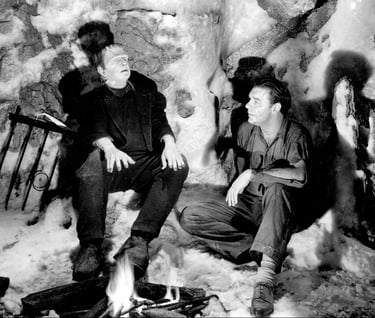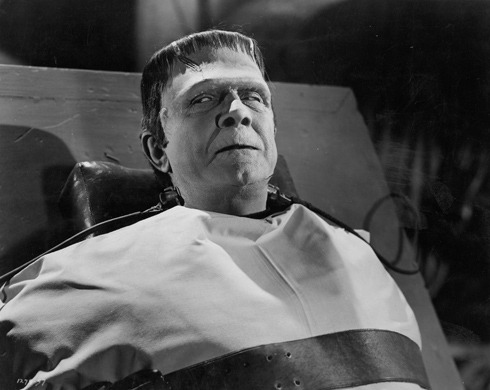Frankenstein Meets the Wolfman (1943)
“He is not insane. He simply wants to die.” – Maleva


By this point, Universal Pictures were being seriously challenged by rival studio RKO Pictures for dominance in the horror field. RKO were churning out thoughtful, moody and artistically made films, albeit with sensational titles like Curse of the Cat People, I Walked with a Zombie and The Bodysnatcher. But as they simply didn’t have the budget of a larger operation like Universal, the monsters were more suggested than seen. And if they were seen, it was a fleeting glance. Universal decided to counter this by giving audiences more monsters for their money, thus was born the short lived era of the “Monster Rally” movies, where Universal were only too happy to cross their individual Monster franchises. I think this might make Frankenstein Meets the Wolf Man Hollywood’s first crossover.
Of course, it also helped keep the Monsters going for just a little while longer. Certainly, the Frankenstein series was beginning to lose momentum since Karloff walked away, Dracula had managed only one sequel, and the Count wasn’t even in it.
The success of The Wolf Man prompted thought and ideas for a sequel. But a fifth Frankenstein was also being considered. The film that resulted served as a continuation to both. But it also became a film often sneered at by horror movie fans who don’t know the backstory. If you know the history – it becomes a much better film than it’s credited as being. And it’s one of the most fun of the Universal Monster movies as a result.
So, when we last left them, the Wolf Man (Lon Chaney) had been bludgeoned to death by his father with a silver headed walking stick, and the Monster (Lon Chaney) had been burned to death in the secret laboratory of Ludwig Frankenstein. There’s a problem. Back in 1943, Chaney couldn’t play both roles. The makeup time alone would amount to hours per day, the split screen technique needed so that Chaney could play opposite himself in a scene would send the budget soaring.
Ingeniously as you’ll recall, the Monster had the evil, scheming and manipulative Ygor’s brain put in his head in the last reel of the previous film and had gone blind. There’s the solution. Ygor had been played by Bela Lugosi. Lugosi was tall enough, he had a menacing presence, and his distinctive face under the make-up would remind audiences that Ygor’s brain was still scheming. Plus – in keeping with the ending of Ghost of Frankenstein – the Monster would still talk and was still blind.
Several scenes were filmed with Lugosi talking and adopting a hesitant stiff walk, with his arms stretched out in front because he’s blind. Then, the producer changed his mind. The Monster having long conversations with Laurence Talbot didn’t work and all the Monster’s dialogue was cut, and with it went every reference to the Monster being blind. Worse, there are a couple of scenes showing the Monster’s mouth moving but no words. This makes Lugosi look like he’s crazily overacting and has never seen the way the Monster moves in any of the previous films. It’s a sad double tragedy. His final performance under contract to Universal was cruelly undermined, and that Lugosi was at this point sixty years old and was reduced to being grateful for a role he had haughtily turned down twelve years later.
As the film opens, we’re treated to one of Universal’s best sets. Possibly the best cemetery set in films, obviously not an exterior set, which adds to its effectiveness. All creaking gates, haphazard gravestones, barren trees and a menacing crow. Seriously, the best horror movie graveyard ever – and to add to it, it’s dusk, windy and there’s a full moon as the final touch appears – two grave robbers, out to plunder the Talbot family tomb. They’ve heard that when Laurence Talbot died four years earlier, he was interred with his watch, ring and some money.
Expecting to see nothing but bones, they find Larry’s body perfectly preserved in the tomb, under a layer of wolfsbane. Uh-oh. Did I say it’s a full moon? (As of this film, the lunar cycle becomes a bigger factor in the Wolf Man’s transformation, so I guess this film might tale place over a span of around three months.)
As the moon clears a cloud, Larry’s hand grasps one of the robbers by the wrist, causing the other to panic and leave (presumably to lead a life of atonement) as a lamp is knocked over, causing a fire (which nobody seems to have attended to).
Somehow, Talbot makes his way to Cardiff, is found by a police constable and taken to hospital where he’s treated for his head wound (the one inflicted by his father who died of a broken heart shortly after). Larry realises that his rampant lycanthropy means he can’t die. He’s cursed to live forever, forever turning into a werewolf at the full moon. His doctor, the dashing Doctor Mannering (Patric Knowles) and the local police think he’s delusional – despite the death of a young girl by having her throat torn out as if by an animal, only streets away. Oh boy.
Talbot escapes from the hospital and makes his way to presumably Eastern Europe in search of the one person who can help him, Maleva, the old gypsy lady, mother of the late Bela who passed the curse of werewolfism to Larry. When he finds her, Maleva (Maria Ouspenskaya) who vows to care for him – and has heard of Ludwig Frankenstein in Vasaria (they changed the spelling this time) who might be able to help him. (Obviously, they haven’t seen Ghost of Frankenstein).
When they reach the town, they’re greeted frostily by the locals who remember Frankenstein bringing nothing but misery with his experiments. (Excuse me, you guys were all over him as a benefactor for most of Ghost…) Plus, they don’t seem to like gypsies and vagrants so they drive Larry and Maleva out of town. But at least they helpfully point out the remnants of the ruined castle after the fire. It’s halfway up a hill with a dam behind it… (Not the way I remember it from last time, when it was a mansion on flat ground.)
It’s the night of the full moon, and Larry turns wolfy and kills a young woman he’d been eyeing up earlier in the tavern. (The locals, led by Dwight Frye in his last film for Universal, he passed away of a heart attack shortly afterward) hear the wolf’s cry and go hunting.
The Wolf Man hides in the remnants of the castle but falls through a weakened floor, to a frozen chamber where he’s been since the place was burned. (Lugosi’s deleted dialogue had it that he’d been conscious all these past years, but unable to move in the ice until Larry helped him out.) Larry asks the Monster to show him where Ludwig Frankenstein kept his diary – but the Monster, blindly stumbling about, comes up short.
Larry decides to lure Ludwig’s daughter Elsa (Ilona Massey) – now Baroness Frankenstein, inexplicably and single. (I guess the fling with the Prosecutor in the last film didn’t work out) to a meeting under the pretence of wanting to buy the ruins of her previous home.
That night at the village, which happens to be the start of their Festival of the New Wine (cue the low point of the film, an annoying song sung by a guy with far too many teeth and bulging eyes too big for his head) Elsa and Larry meet Mannering, who’s been following Talbot through Europe by reading newspapers and heading for where the animalistic killings occur. Cue the Monster crashing the party (the original cut dialogue explained this by having the Monster telling Talbot he was afraid he’d been left behind forever) and upsetting the villagers. Talbot and the Monster escape in a cart, Mannering and Elsa agree to help rid the village of the curse, along with Maleva, who’s been under arrest since Larry turned wolf on their first night in the area.
The trio head for the castle, where Elsa shows Mannering where her father’s notes are hidden. The plan is to use Frankenstein’s equipment (which survived the building being razed to the ground) to draw the energy out of the Monster, thus killing him by literally powering him down. Larry wants to die also, to end his curse and asks the same be done to him.
The machines don’t take any fixing, seemingly and are good and ready to go. But there’s a scene that I noticed for the first time as Elsa and Talbot are talking as he’s waiting to be called through to the procedure. It’s subtle. So subtle I’d never noticed it. As Larry is pacing, the Monster is obviously watching him and as Larry faced the Monster, he instantly goes back to acting as if he’s blind. This leads me to believe that the Monster’s eyesight is beginning to return, and with Ygor’s brain, is plotting. This adds an extra dimension to the film.


BUT – Mannering has had second thoughts, and in an inexplicable scene where he talks to himself, he succumbs to the temptation NOT to destroy the Monster. Instead, he wants to see it at full power. So when both Larry and the Monster are hooked up, he ramps the power up.
The Monster’s expression becomes one of smug satisfaction, and it’s obvious his sight has fully returned as he breaks free of his binding restraints and attacks Mannering, while the full moon rises and everybody’s problems have doubled – the Wolf Man is loose. No wonder Mannering and Elsa get the hell out of Dodge, though they seem to leave poor Maleva to her fate.
The ensuing fight between the Monster and the Wolf Man is short, but spectacular and comes to an abrupt end when the surly Innkeeper blows the dam with dynamite, destroying the castle while the villagers, led by their mayor (Lionel Atwill) cheer – possibly not realising that they’ve not only just lost their water supply but their homes have all been swept away as well.
As for the Monster and the Wolf Man? That’s another story for another day.
